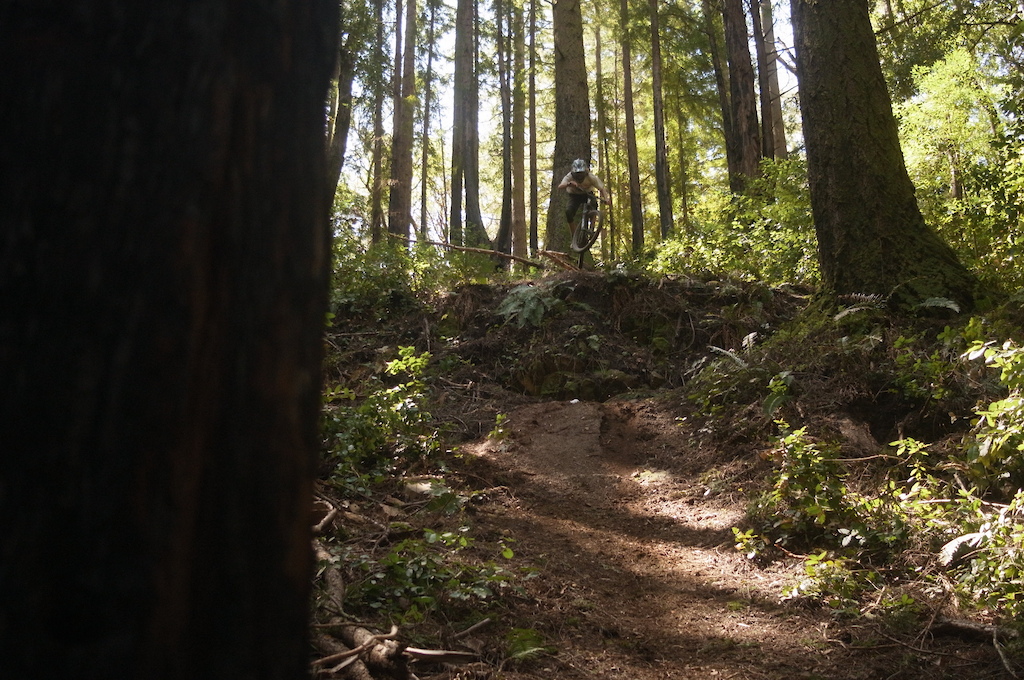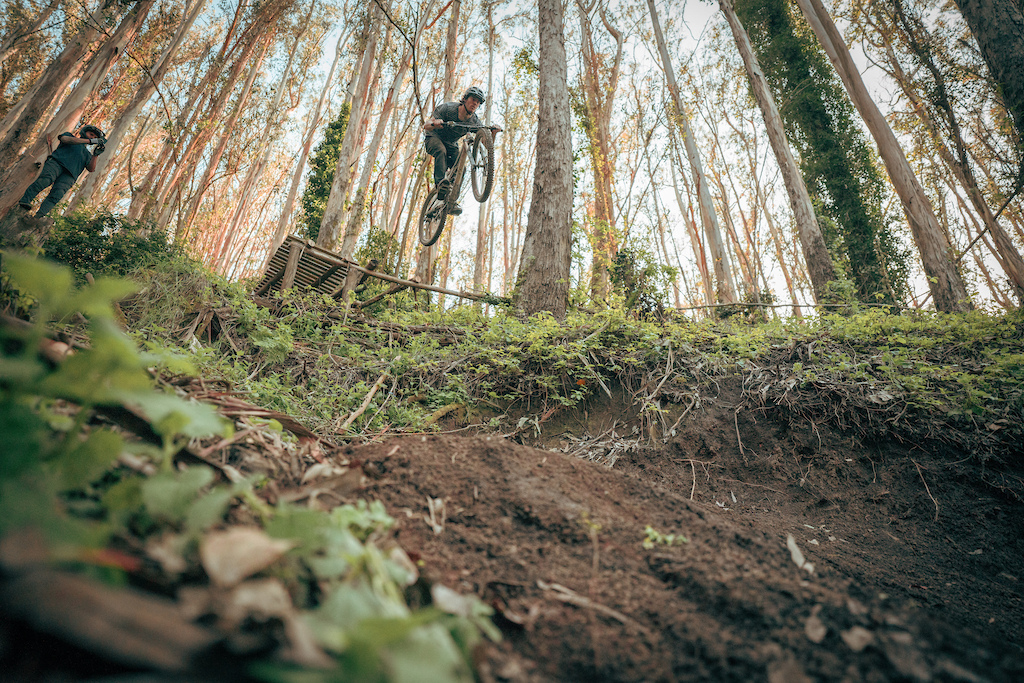Reader Story: Does Pedal Kickback Actually Happen?
The debate over pedal kickback is ongoing, and depending on who you ask it's either a minor, almost imperceptible phenomenon, or a major issue that needs to immediately be addressed with an idler. Pinkbike's Seb Stott recently wrote an article detailing exactly why you shouldn't worry about it.
If you shouldn't worry, is it actually noticeable? Pinkbike reader Matt Morrison took matters into his own hands, and even created his own data acquisition setup and software. It's great to see riders go this far to try and figure out if what they're feeling can be backed up by data. - Mike Kazimer
Words: Matt Morrison
You have probably heard of pedal kickback. But, like me, you probably aren’t sure if it actually happens out on the trail. No amount of Pinkbike articles, YouTube videos, or trailside debates on the topic could really tell me if I ever experience it while riding. So I decided to directly measure pedal kickback events out on the trail. I spent a few months developing a data acquisition system and a suite of software tools for the job.
I made sensors for the bike that enabled me to compute when pedal kickback occurred while riding. Funnily enough, the most important of these sensors was a simple button on my handlebars. I pressed it when I suspected I felt pedal kickback at my feet. This “rider feedback” button is crucial because we can collect data all day long, but if we cannot ultimately correlate these quantitative results with any meaningful rider feedback, the data doesn’t really mean anything. We are generally saturated with data and yet starved for understanding—and for this test, what I craved was understanding.
I really had no idea what to expect from the results, but I had a hunch that occasional bouts of harshness felt at my feet while riding might be due to pedal kickback. I ran five laps at my local trail network and did two runs of a fairly large, slow-speed drop in the area. The general consensus is that slow-speed drops are where the rider is most liable to experience pedal kickback, so I was glad to get this data included in my field test.
The video explains all the fine details, but, long story short, pedal kickback happens! There were several instances of perceptible pedal kickback during the field test. This means pedal kickback not only occurred but I also hit the feedback button, indicating I actually felt it as well. I can’t extrapolate the results beyond the scope of my test, but at least I proved to myself that pedal kickback happens for me. Let me know what I got right, what I got wrong, and what topic I should research next.
Cass Labs
If you shouldn't worry, is it actually noticeable? Pinkbike reader Matt Morrison took matters into his own hands, and even created his own data acquisition setup and software. It's great to see riders go this far to try and figure out if what they're feeling can be backed up by data. - Mike Kazimer
Words: Matt Morrison
You have probably heard of pedal kickback. But, like me, you probably aren’t sure if it actually happens out on the trail. No amount of Pinkbike articles, YouTube videos, or trailside debates on the topic could really tell me if I ever experience it while riding. So I decided to directly measure pedal kickback events out on the trail. I spent a few months developing a data acquisition system and a suite of software tools for the job.
I made sensors for the bike that enabled me to compute when pedal kickback occurred while riding. Funnily enough, the most important of these sensors was a simple button on my handlebars. I pressed it when I suspected I felt pedal kickback at my feet. This “rider feedback” button is crucial because we can collect data all day long, but if we cannot ultimately correlate these quantitative results with any meaningful rider feedback, the data doesn’t really mean anything. We are generally saturated with data and yet starved for understanding—and for this test, what I craved was understanding.
I really had no idea what to expect from the results, but I had a hunch that occasional bouts of harshness felt at my feet while riding might be due to pedal kickback. I ran five laps at my local trail network and did two runs of a fairly large, slow-speed drop in the area. The general consensus is that slow-speed drops are where the rider is most liable to experience pedal kickback, so I was glad to get this data included in my field test.
Hunting for pedal kickback events (photo: Zack Watkins)
The video explains all the fine details, but, long story short, pedal kickback happens! There were several instances of perceptible pedal kickback during the field test. This means pedal kickback not only occurred but I also hit the feedback button, indicating I actually felt it as well. I can’t extrapolate the results beyond the scope of my test, but at least I proved to myself that pedal kickback happens for me. Let me know what I got right, what I got wrong, and what topic I should research next.
Another huck liable to produce pedal kickback (photo: Nick Mullen)
Cass Labs
Author Info:
Must Read This Week
Sign Up for the Pinkbike Newsletter - All the Biggest, Most Interesting Stories in your Inbox
PB Newsletter Signup



The subjective experience part is interesting though! Understanding if we really feel kickback is one thing, but (if the processing speed is possible) I could also imagine an inverse setup that gives immediate rider feedback when kickback is detected being a useful way to help riders become more in attuned to what their bike is doing.
Kickback in this experiment is inferred, not measured.
But how would you measure it at the cranks?
Position - it would be hard to differentiate between natural leg movement in the rider or other "noise" and actual kickback.
Force, power meter? (well strain in the pedal or crankarm or chainring) - again, really hard to differentiate between rider input or other noise.
If you just wanted to prove kickback exists, maybe fit a "dummy" chainring which free rotates around the crank axle, then you can just measure rotation, easy to spot it occurring then.
I’m not sure what the raw data looks like from a strain gauge but I’m guessing it would be a momentary signal spike, and would look quite different from normal trail chatter, big hits, acceleration, etc.
You could test this by doing a pedaling wheelie off a curb. This is where pedal kickback is most apparent, and there’s no other noise to skew the signal.
Power meters measure torque and angular velocity to compute the power. I would image pedal kickback to show up like a spike in torque with the angular velocity reducing or going negative.
I'm not sure how much this would stand out from noise in the sensors. Especially since power meters as far as I know use an accelerometer to measure angular velocity, so you'd see a big spike just from the impact of the drop. I don't think you can get meaningful sub-second angular velocity measurements from them.
I think head units get these two number separately, at least from a power2max. If you could get that data out it would be worth a look.
I think the best way might be to measure the force on each pedal. If there's more force on your leading foot when you land then the pedals kicked back. If the forces are the same, then they didn't.
Thanks for the education! That’s more complicated than I would have expected. Good idea using a meter on both cranks… would definitely expect to see the affect disproportionately on the front foot!
It would be great to see bike industry journalists go this far and figure out if the BS they spout for profit can be backed up by data.
With the OChain the chain never puts significant tension on the cassette so the chain doesnt have that sharp tug on the cassette.
Removing the chain will surely feel smoother and that can be mistaken for pedal kickback being a thing going downhill.
Now, leave the chain on, but remove the hub's pawls. There won't be chance of engagement, so whatever you feel won't be kickbak
...and surely you'll feel something lol
(hint: is the bloody chain slap!)
It strange how marketing bullshit becomes technical truth and people will defend it with no knowledge of the behaviour. In fact magazines and media outlets are very responsible for propagating the un-truths too....
There's a good write up on Bike Rumour, with lots of bike brands (technical people) talking about their high pivot bike, they all understand the behaviour correctly, but the marketing team picks the bits that sound good and distort the truth!
A couple minor observations on my part: Your apparatus isn’t actually measuring pedal kickback though, right? If I understood that correctly, it measures a set of circumstances under which we would presume pedal kickback to occur. But not the actual angular momentum / force pulling backwards on the cranks. Maybe that could be measured with accelerometers on the cranks. Under these circumstances, assuming instant hub engagement is also quite a big assumption that might skew the conclusions. This, and the amount of false positives compared to the much smaller amount of true positives and even smaller amount of „significant positives“, lead me to believe that pedal kickback might not be the only effect you have felt while riding. There might have been something else in the mix aswell. It might also be useful to introduce some references to better be able to determine what is a „significant positive“.
That’s not to say that I think the measurements themselves were inaccurate or inadequate. I’m honestly super impressed with your work and the length you went to for this little experiment.
No offense Pinkbike editors, but this was certainly the most interesting article I’ve seen here in some time.
One thing I wonder is, maybe 5 seconds is too long a margin between actual kickback and hitting the button? Could be getting a false positive on what you thought you perceived and then got an actual kickback within that 5 seconds that you didn’t actually feel?
Well done video and experiment!
I agree with the poster above who said that this is an indirect indicator - albeit impressively done - of pedal kickback rather than a direct measurement. I wonder if it might be possible to use a crank based power meter to measure spikes in strain/force at the chainring to detect the event... in theory without pedal kickback there ought to be almost no forces on the strain gauge while descending (and not pedaling).
The cool thing you could do with this tool though, is study what level of kickback is perceptible. Try different bikes, different riders, different gears (is gear taken into account in your setup? Looks like it isn't?). Another interesting question is: what leads to false positives?
If I may suggest I would also include measurement of a discrete, single event input and minimizing all other variables e.g. going over a rubber speed bump on flat ground. This can be done at different speeds, gear position and rider position (seated vs. standing).
As another commented pointed out, power meter can also be used to actually measure the force on the pedal directly rather than resolving the crank angular velocity via the shock displacement - which is complicated by the nonlinear shock ratio (I suppose you have taken this into account).
Agree with your point on the suspension sound/noise and how it changes perception on subjective feel. This is a well known fact in the car industry when evaluating subjective performance - the NVH pack level does provide a big influence on how one perceives the harshness of ride events such as impacts, rolling on rough surface, etc.
Everything worked better. Chassis was more stable, so braking was more effective and fork more composed. Line choice was easier and it opened up a completely different way to ride the trail. It was like riding a pro-level bike.
An ochain is now the only upgrade I’m interested in now.
I built a 2017 Canfield balance for one of my kids (cause it was cheap) and I rode it a few times. Couldn’t believe how good it was. The high kickback bike’s definitely have more efficiency on smooth climbs but the CBF blows them out of the water. Enough that I bought a new Tilt for myself this year. I think the o chain could be a game changer bug is soooo expensive of an experiment. Demo a Canfield, you won’t believe it till you ride it. It still blows me away
More about the difference in confidence than speed, me thinks.